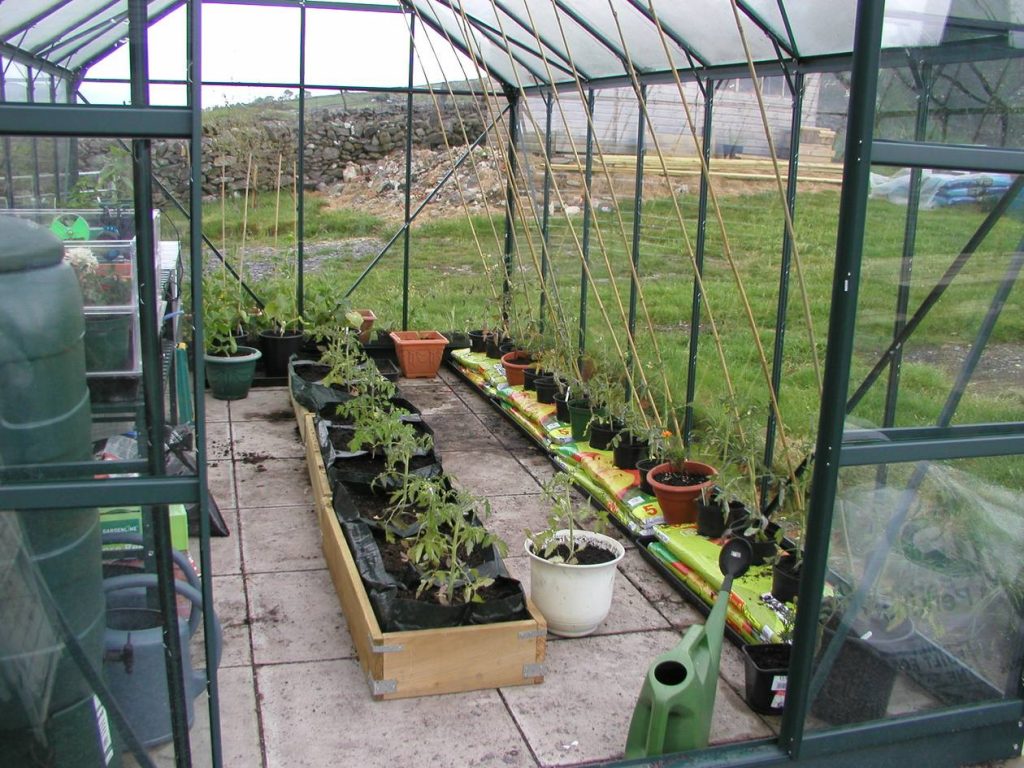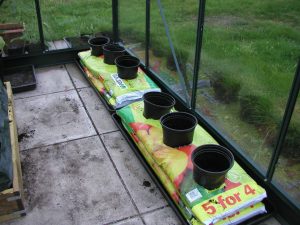The advantage of greenhouse growing tomatoes in pots and grow bags is that the compost is fresh each year. This means that it is free from disease build up and pests. Once the season is over, the spent compost from the pots and grow bags can be used as a soil improver on the plot.
The disadvantages of grow bags are that the limited volume of growing medium cannot hold enough nutrients for the season or water for an extended period.
This forces the use of liquid feeds, whether commercial or home made. Unless these feeds are correctly formulated and used, they can cause problems such as magnesium deficiency.
The limited water retention capacity can also lead to problems. The compost only has to dry out for a matter of hours to cause blossom end rot and or split skins on the fruits. Regular watering, whenever needed, is vital to successful growing in containers.
You can improve the water retention capacity by adding water absorbent crystals to the compost but that is not a replacement for frequent watering, just an aid.
What size pot to use for growing tomatoes?
Basically, the larger the pot the better. The minimum size is a 10” (20cm) pot which holds approximately 10 litres of compost. I have some 10” pots picked up from supermarkets that they used for cut-flowers. By drilling drainage holes these became useful cheap pots.
I’ve also got some 12” (30 cm) square planters that hold around 25 litres of compost. These are far better as they hold more water, reducing the risk of the compost drying out and causing problems.
Finally I’ve got some 100 litre containers that take three tomato plants easily.
Pots versus Grow bags
Pots do have an advantage over grow bags in that you can use a decent quality compost in the pot. Many grow bags use very poor quality compost.
Grow bags for Tomatoes
The only drawback was watering. One way to solve this was a variant on the old ring-culture growing method. Another solution was grow bag watering pots. These are inserted into the bag and water easily added through them,
As time has gone on, commercial pressures have decreased both the quality of the compost in grow bags and the volume of them. Nowadays most grow bags are around 35 to 40 litres capacity. This is the bare minimum for growing tomatoes successfully.
In hot weather with fully grown plants, these small grow bags may require watering three times a day to keep the compost moist. The best answer is to increase the volume of compost.
I have used both of the following methods and a combination of them to increase the volume of compost available to the tomato plants.
Taking some old 8 or 9” pots, cut the base off making them into bottomless pots. Use the pot as a template to cut round at the top of the bag and screw the pot an inch or two into the bag.
Plant into the pot as normal, filling it with compost. Water both into the pot and the bag using grow bag watering pots.
The second method is not as convenient but does work. Set up a grow bag as normal with drainage holes but cut away most of the top. Then cut away most of the base of a second bag and place on top of the first.
Cut planting and watering holes into the top bag and you’ve effectively doubled the volume of compost for your plants.
Further Information: Tomato Growing Guides
- Grow Unusual Tomatoes!
- Types of Tomatoes – An Introduction to Tomato Growing Part 1
- Sowing and Starting off Tomatoes – Introduction to Tomato Growing Part 2
- Growing Tomatoes in a Tomato Grow-house (Mini-Greenhouse)
- Growing Tomatoes in a Greenhouse
- Growing Tomatoes in the Greenhouse Border
- Growing Tomatoes in Pots or Grow Bags in the Greenhouse
- Growing Tomatoes by Ring Culture
- Growing Tomatoes in Straw Bales
- Growing Tomatoes Outdoors
- Planting & Growing Tomatoes Outdoors
- Growing Patio Tomatoes – Dwarf Bush Variety Patio Tomatoes
- Water Requirements for Tomatoes
- Ideal Temperatures for Growing Tomatoes
- Removing Tomato Side Shoots (Suckers) & Stopping Tomatoes
- Best Tomato Varieties – My Top Tasty Tomato Picks
- Heirloom Tomatoes (Heritage Tomatoes)
- Best Tomatoes for Greenhouse Growing
- Tomato Troubles & Diseases | Causes & Cures of Tomato Problems
- Raising Tomato Plants from Seed





